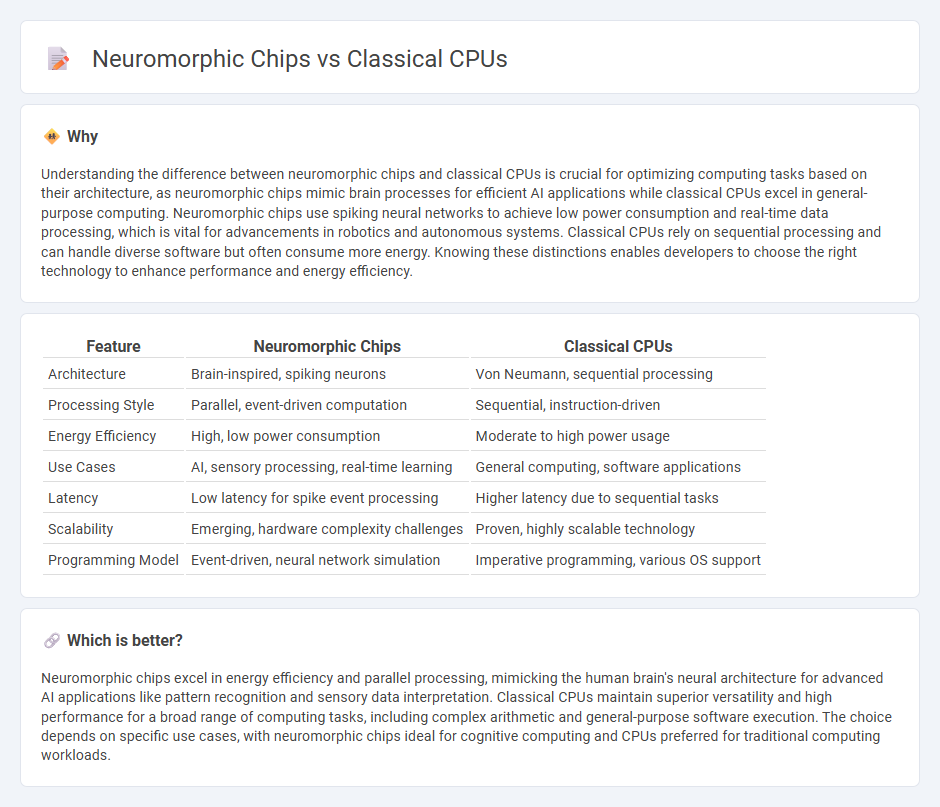
Neuromorphic chips mimic the human brain's neural architecture to process information with high efficiency and low power consumption, contrasting classical CPUs that rely on sequential, clock-driven operations. These chips excel in pattern recognition and sensory data processing, making them ideal for AI and real-time computing tasks. Discover more about how neuromorphic technology is revolutionizing computing paradigms.
Why it is important
Understanding the difference between neuromorphic chips and classical CPUs is crucial for optimizing computing tasks based on their architecture, as neuromorphic chips mimic brain processes for efficient AI applications while classical CPUs excel in general-purpose computing. Neuromorphic chips use spiking neural networks to achieve low power consumption and real-time data processing, which is vital for advancements in robotics and autonomous systems. Classical CPUs rely on sequential processing and can handle diverse software but often consume more energy. Knowing these distinctions enables developers to choose the right technology to enhance performance and energy efficiency.
Comparison Table
| Feature | Neuromorphic Chips | Classical CPUs |
|---|---|---|
| Architecture | Brain-inspired, spiking neurons | Von Neumann, sequential processing |
| Processing Style | Parallel, event-driven computation | Sequential, instruction-driven |
| Energy Efficiency | High, low power consumption | Moderate to high power usage |
| Use Cases | AI, sensory processing, real-time learning | General computing, software applications |
| Latency | Low latency for spike event processing | Higher latency due to sequential tasks |
| Scalability | Emerging, hardware complexity challenges | Proven, highly scalable technology |
| Programming Model | Event-driven, neural network simulation | Imperative programming, various OS support |
Which is better?
Neuromorphic chips excel in energy efficiency and parallel processing, mimicking the human brain's neural architecture for advanced AI applications like pattern recognition and sensory data interpretation. Classical CPUs maintain superior versatility and high performance for a broad range of computing tasks, including complex arithmetic and general-purpose software execution. The choice depends on specific use cases, with neuromorphic chips ideal for cognitive computing and CPUs preferred for traditional computing workloads.
Connection
Neuromorphic chips and classical CPUs are connected through hybrid computing architectures that leverage the strengths of both for enhanced performance and efficiency. These systems utilize classical CPUs for sequential processing tasks while neuromorphic chips handle parallel, brain-inspired computations, improving real-time data processing in AI and machine learning applications. Integration occurs via specialized interconnects and middleware that facilitate communication and data exchange between the two processor types.
Key Terms
Von Neumann architecture
Classical CPUs operate based on the Von Neumann architecture, which separates memory and processing units, leading to the well-known bottleneck in data throughput. Neuromorphic chips mimic the structure of biological neural networks, integrating memory and processing to achieve highly parallel and energy-efficient computations. Explore further to understand how this architectural shift impacts AI and future computing paradigms.
Spiking neural networks
Classical CPUs process information sequentially using binary logic, which limits efficiency for complex neural computations compared to neuromorphic chips designed to mimic the brain's architecture. Neuromorphic chips excel in executing Spiking Neural Networks (SNNs) by utilizing asynchronous event-driven operations that replicate neuronal spikes, leading to lower power consumption and faster processing speeds in pattern recognition and sensory tasks. Discover how Spiking Neural Network implementations on neuromorphic hardware surpass traditional CPUs in various AI applications.
Parallel processing
Classical CPUs execute instructions sequentially, relying on multiple cores for limited parallelism, which often leads to bottlenecks in complex computations. Neuromorphic chips mimic the human brain's architecture, enabling massively parallel processing through interconnected artificial neurons, resulting in enhanced efficiency and speed for tasks like pattern recognition. Explore the latest advancements in neuromorphic technology to understand its transformative impact on parallel computing.
Source and External Links
Classical vs. quantum computing: What are the differences? - Classical CPUs are silicon-based, operate via Boolean logic with transistors, and their computing power increases linearly with transistor count, making them well suited for everyday environments like laptops and data centers operating at normal temperatures.
The Difference Between Classical and Quantum Computing - A classical CPU uses bits that are either 0 or 1, is based on transistor logic, requires external memory, and its computational capacity grows linearly with the number of bits and transistors, providing reliable speed and parallel processing capabilities.
Quantum Computing vs Classical Computing - Classical computers perform computations by processing *N* bits for up to *N* simultaneous calculations, lack intrinsic learning or intelligence, and fundamentally differ from quantum computers whose performance scales exponentially with qubits.
 dowidth.com
dowidth.com